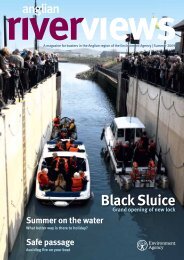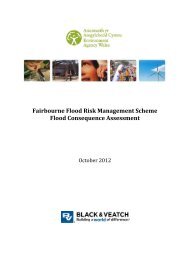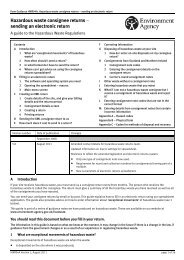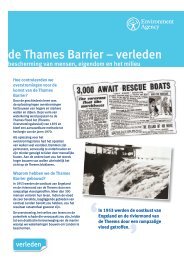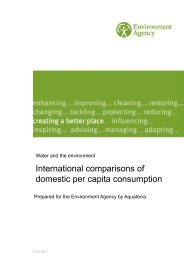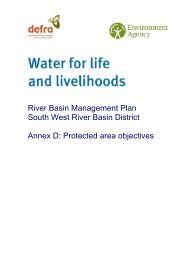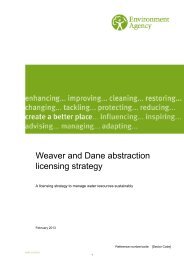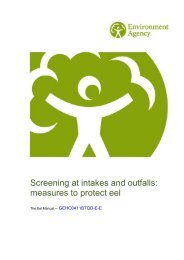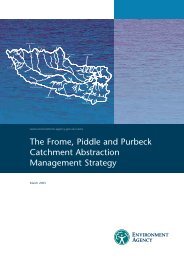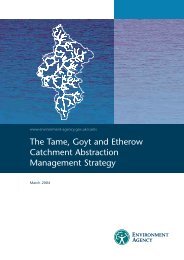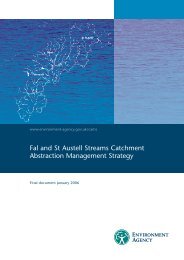preliminary flood risk assessment drain london
preliminary flood risk assessment drain london
preliminary flood risk assessment drain london
Create successful ePaper yourself
Turn your PDF publications into a flip-book with our unique Google optimized e-Paper software.
The surface water maps are not designed to assess the <strong>risk</strong>s from other sources of <strong>flood</strong>ing.<br />
However, as these datasets use a 2D representation of the ground, they route surface runoff<br />
into channels and depressions. As <strong>flood</strong>ing is dependent on topography and depressions,<br />
<strong>flood</strong>ing from ordinary watercourses and groundwater may occur in the same places as <strong>flood</strong>ing<br />
from surface runoff.<br />
Drain London LBB Surface Water Mapping<br />
A Surface Water Management Plan (SWMP) is currently being completed for the LBB as part of<br />
the wider Drain London project. A direct rainfall model has been developed as part of this<br />
project to assess local surface water <strong>flood</strong> <strong>risk</strong> within the LBB. The full modelling methodology<br />
is outlined in the LBB SWMP report. The full modelling methodology is outlined in the LBB<br />
SWMP report, but in summary:<br />
• Modelling was carried out in Tuflow following a direct rainfall approach. A standard 5m<br />
mesh size was used.<br />
• Net (effective) rainfall was variable according to land surface and to the capacity of the<br />
sewerage system, set by Thames Water at 6.5mm/hour.<br />
• The 3.33%, 1.33%, 1%, 1% allowing for climate change (a 30% increase in rainfall) and<br />
0.5% annual probability rainfall events were run.<br />
• Key 1D structures (in particular culverts inflowing from urban areas) were included where<br />
sufficient information was available. The sewerage system was not explicitly modelled.<br />
• Main Rivers were assumed to be bank-full.<br />
The surface water modelling validated using local Borough knowledge and through reference to<br />
the FMfSW shallow and deep outlines to establish if there was a correlation between the<br />
mapped areas identified at <strong>risk</strong>. There was a good match between the Drain London mapping<br />
and the EA FMfSW. The Drain London mapping identified clearer connections between areas<br />
of <strong>flood</strong>ing as well as showing flow velocity and hazard.<br />
The hazard mapping produced should be treated with caution as inconsistencies in the LiDAR<br />
surface as a result of inconsistent processing have resulted in areas where there is no surface<br />
water <strong>flood</strong>ing being given a high hazard rating.<br />
The 1 in 200 year depth grid is illustrated in drawing number 2107-UA002334-BMD-01 and the<br />
1 in 200 year hazard grid is illustrated in drawing number 2108-UA002334-BMD-01.<br />
The Drain London modelling methodology is an improvement on the national scale mapping<br />
generated by the EA. Therefore the modelled mapping from this study has been used as the<br />
main source of data to determine the significance of surface water <strong>flood</strong>ing within the LBB.<br />
Summary<br />
Both the EA and Drain London surface water mapping identify the areas adjacent to the natural<br />
river valleys of the River Brent and Wealdstone Brook as the main areas at <strong>risk</strong>. Elsewhere<br />
minor watercourses, that have largely been subsumed into the below ground urban <strong>drain</strong>age<br />
system, remain as important pathways during extreme flows, such as Kenton Brook, Wembley<br />
Brook and Northwick Park Drain.<br />
Flatter areas of the Borough (e.g. Dollis Hill, Kilburn, Willesden and Wembley) show flow<br />
pathways that are less defined, with ponding occurring in an irregular pattern, though generally<br />
not to a depth where large numbers of properties would be <strong>flood</strong>ed. As such, this is an<br />
important item to note because surface water <strong>flood</strong> <strong>risk</strong> is not confined to specific areas of the<br />
Borough – all parts are susceptible to varying degrees and have some <strong>risk</strong> associated.<br />
UA002334 - Drain London— London Borough of Brent PFRA<br />
Hyder Consulting (UK) Limited-2212959 Page 17<br />
o:\frr review monitoring & reporting team\publishing\unknown\brent\brent_par.docx



